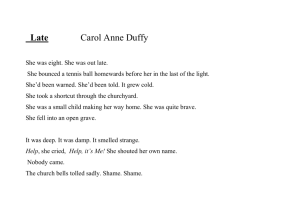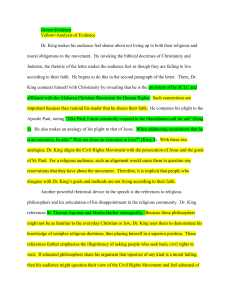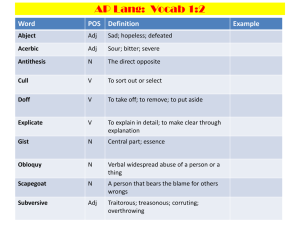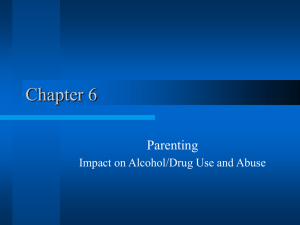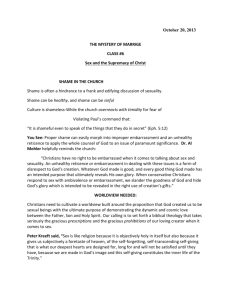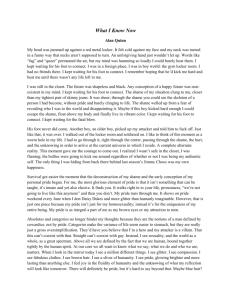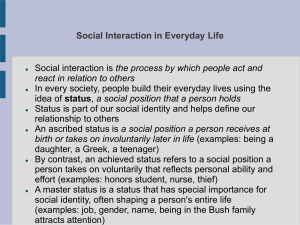Shame as the Master Emotion of Everyday Life
advertisement
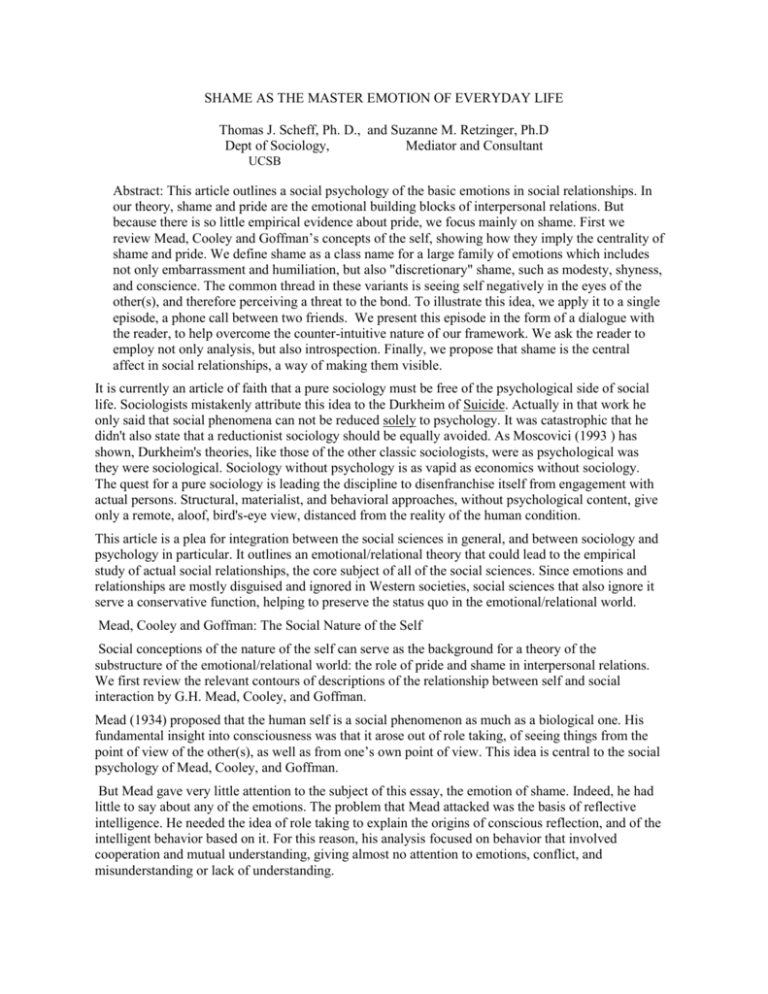
SHAME AS THE MASTER EMOTION OF EVERYDAY LIFE Thomas J. Scheff, Ph. D., and Suzanne M. Retzinger, Ph.D Dept of Sociology, Mediator and Consultant UCSB Abstract: This article outlines a social psychology of the basic emotions in social relationships. In our theory, shame and pride are the emotional building blocks of interpersonal relations. But because there is so little empirical evidence about pride, we focus mainly on shame. First we review Mead, Cooley and Goffman’s concepts of the self, showing how they imply the centrality of shame and pride. We define shame as a class name for a large family of emotions which includes not only embarrassment and humiliation, but also "discretionary" shame, such as modesty, shyness, and conscience. The common thread in these variants is seeing self negatively in the eyes of the other(s), and therefore perceiving a threat to the bond. To illustrate this idea, we apply it to a single episode, a phone call between two friends. We present this episode in the form of a dialogue with the reader, to help overcome the counter-intuitive nature of our framework. We ask the reader to employ not only analysis, but also introspection. Finally, we propose that shame is the central affect in social relationships, a way of making them visible. It is currently an article of faith that a pure sociology must be free of the psychological side of social life. Sociologists mistakenly attribute this idea to the Durkheim of Suicide. Actually in that work he only said that social phenomena can not be reduced solely to psychology. It was catastrophic that he didn't also state that a reductionist sociology should be equally avoided. As Moscovici (1993 ) has shown, Durkheim's theories, like those of the other classic sociologists, were as psychological was they were sociological. Sociology without psychology is as vapid as economics without sociology. The quest for a pure sociology is leading the discipline to disenfranchise itself from engagement with actual persons. Structural, materialist, and behavioral approaches, without psychological content, give only a remote, aloof, bird's-eye view, distanced from the reality of the human condition. This article is a plea for integration between the social sciences in general, and between sociology and psychology in particular. It outlines an emotional/relational theory that could lead to the empirical study of actual social relationships, the core subject of all of the social sciences. Since emotions and relationships are mostly disguised and ignored in Western societies, social sciences that also ignore it serve a conservative function, helping to preserve the status quo in the emotional/relational world. Mead, Cooley and Goffman: The Social Nature of the Self Social conceptions of the nature of the self can serve as the background for a theory of the substructure of the emotional/relational world: the role of pride and shame in interpersonal relations. We first review the relevant contours of descriptions of the relationship between self and social interaction by G.H. Mead, Cooley, and Goffman. Mead (1934) proposed that the human self is a social phenomenon as much as a biological one. His fundamental insight into consciousness was that it arose out of role taking, of seeing things from the point of view of the other(s), as well as from one’s own point of view. This idea is central to the social psychology of Mead, Cooley, and Goffman. But Mead gave very little attention to the subject of this essay, the emotion of shame. Indeed, he had little to say about any of the emotions. The problem that Mead attacked was the basis of reflective intelligence. He needed the idea of role taking to explain the origins of conscious reflection, and of the intelligent behavior based on it. For this reason, his analysis focused on behavior that involved cooperation and mutual understanding, giving almost no attention to emotions, conflict, and misunderstanding or lack of understanding. 2 The social psychology of one of Mead’s forerunners, Charles Cooley, similarly focused on cooperation and understanding. However, when Cooley considered his version of the role-taking process, which was quite similar to Mead’s, he noted that this process would usually generate emotions. For Cooley (1922), shame and pride both arose from seeing oneself from the point of view of the other, the process that was at the center of his social psychology. In his discussion of what he called the “selfsentiments,” pride and shame are mentioned only as two of other possible emotions. But his concept of "the looking glass self," which implies the social nature of the self, refers directly and exclusively to pride and shame. Cooley saw self-monitoring in terms of three steps (l84): "A self-idea of this sort seems to have three principal elements: the imagination of our appearance to the other person; the imagination of his judgment of that appearance, and some sort of self-feeling, such as pride or mortification." In this passage he restricts self-feelings to the two which he seems to think are the most significant, pride and shame (considering "mortification" to be a shame variant). To make sure we understand this point, he mentions shame three more times in the passage that follows (l84-85, emphasis added): “The comparison with a looking-glass hardly suggests the second element, the imagined judgment, which is quite essential. The thing that moves us to pride or shame is not the mere mechanical reflection of ourselves, but an imputed sentiment, the imagined effect of this reflection upon another's mind. This is evident from the fact that the character and weight of that other, in whose mind we see ourselves, makes all the difference with our feeling. We are ashamed to seem evasive in the presence of a straightforward man, cowardly in the presence of a brave one, gross in the eyes of a refined one and so on. We always imagine, and in imagining share, the judgments of the other mind. A man will boast to one person of an action—say some sharp transaction in trade—which he would be ashamed to own to another.” Goffman also pursued the idea of emotions arising out role taking, but formulated it in a way that was less direct than Cooley. But more than Cooley, and much more than Mead, Goffman fleshed out the dynamics of role-taking by providing many, many extended examples. These examples allow the reader concrete understanding of ideas that are only abstractions in Mead and Cooley. It is relevant to this article that Mead and Cooley's approach to social psychology appears to have been based largely on introspection. Neither were empirical researchers. It is unfortunate that modern social science has been turning away from introspection as a mode of research. Relationship and shame dynamics are extremely difficult to understand in Western societies without introspection because most relationship details are ignored, and shame is almost, but not quite completely, hidden. Introspection as a method of research has a significant role in this article. Goffman on Embarrassment Goffman also pursued the idea of emotions arising out role taking, but stated less explicitly than Cooley. What Goffman lacked in explicitness, however, he more than made up in the concreteness of his exposition. More perhaps than any other sociologist, Goffman fleshed out Cooley's idea of the looking glass self. In his later work, this theme received less attention. But in most of the earlier work (1959; 1959a; 1963; 1963a; 1967) Goffman provided many concrete examples that convey the look and feel of continually seeing one's self through the eyes of the other(s). Before describing Goffman's contribution to emotion dynamics in relationships, it will be first necessary to define the way we use the word shame. Goffman referred to embarrassment in social interaction, but seldom to shame. Even in the book Stigma, in which shame is a central subject, he used the word shame only twice, both times casually and in passing. More frequently and much less casually, Goffman not only referred to embarrassment but also theorized about it (1967). 3 By our definition, however, embarrassment is one particular type of shame. Humiliation is another. There are many words that are used as substitutes or cognates, that is, for the feeling that results from seeing one's self negatively in the eyes of the other, such as feeling "self-conscious, rejected, unworthy, or inadequate." We will define shame as a class name for a large family of emotions and feelings that arise through seeing self negatively, if even only slightly negatively, through the eyes of others, or even for only anticipating such a reaction. Our definition is in conflict with vernacular usage, in which shame is defined narrowly, as an extreme crisis emotion, what might be called disgrace shame. But in our usage, most shame does not involve crisis or disgrace. It is rather routinely available in the interior theatre of the imagination: modesty, shyness, self-consciousness, conscience (Schneider 1977 calls it discretion-shame). Since our usage of the word includes both disgrace and discretion-shame, perhaps we should call this class name shame, to distinguish it from ordinary usage. Goffman's most powerful contribution to our knowledge of relationships was that shame, or much more frequently anticipation of shame, is a continuing presence in most social interaction. There were four other sociologists, in addition to Goffman and Cooley, who stated or implied that shame was a motive in behavior: Simmel (1904), Norbert Elias (1994), Helen Lynd (1968), and Richard Sennett (1972; 1980)1. But much more than any of these other authors, more even than Lynd (1968) Goffman implied that what we are calling shame was the dominant emotion of social interaction. Goffman’s idea of impression management, which formed the core of much of his work, made the avoidance of shame and embarrassment the central motive of interpersonal behavior, but without naming shame directly, as Cooley did. In his early work on presentation of self, embarrassment and avoidance of embarrassment is the central thread. Goffman’s Everyperson is always desperately worried about her image in the eyes of the other, trying to present herself with her best foot forward to avoid shame. This work elaborates and vivifies Cooley’s abstract idea of the way in which the looking glass generates shame, giving the idea roots in the reader’s imagination. Goffman also made the key sociological point about embarrassment: it arises out of disparities, real, anticipated, or just imagined, in the amount of deference, NO MATTER HOW SLIGHT the disparity. Everyone is extremely sensitive to the exact nuance of deference they receive. This is Goffman's key contribution to shame dynamics. It is this idea that gives rise to treating shame as the central emotion in social interaction. As already indicated, this usage differentiates our conception of shame from the vernacular one, which considers only crisis and disgrace. Goffman affirmed Cooley’s point on the centrality of the emotions of shame and pride in normal, everyday social relationships. In Goffman’s language: “One assumes that embarrassment is a normal part of normal social life, the individual becoming uneasy not because he is personally maladjusted but rather because he is not… embarrassment is not an irrational impulse breaking through social prescribed behavior, but part of this orderly behavior itself” (1967, p. 109 and 111.) Goffman’s method of approaching emotions also made a crucial advance over the work of Mead and Cooley, in that Goffman based most of his work on the close analysis of actual instances of behavior. This approach differentiated him from the highly abstract formulations of Mead and Cooley. In his theoretical statements, Mead allowed for the importance of the nonverbal components of communication, when he referred to the “conversation of gestures.” But he didn’t examine empirical instances. Both in his theoretical work and his analysis of instances, Goffman noted the importance of the gestural components of interaction. But his analysis of instances was not detailed. Like most analysts of texts and most ethnographers, he didn’t try to identify all of the gestures in dialogue and the precise details of context, and therefore ignored most of the emotional content. Nor did he examine the context in detail, especially the extended context, what happened before and after the episode. 1 Reference to a publication by one of the authors. 4 Since shame is elaborately hidden and disguised in Western civilization, an extremely close examination of the verbal, gestural, and contextual details is needed to uncover it. In traditional and Asian societies, the central importance of shame is taken for granted. Indeed, in some Asian societies, such as Japan, it is seen as the central emotion. In a traditional society like the Maori, shame (they call it whakamaa) is also treated as the key emotion. Indeed, the whole approach to shame and relationships in this essay would be seen as platitudinous by the Maori, news from nowhere (Metge 1986). But in Western societies, treating shame as highly significant in everyday life is counter-intuitive and even offensive. Western societies focus on individuals, rather than on relationships. Emerson, because of his emphasis on self-reliance as an antidote to blind conformity, was one of the prophets of individualism: “When my genius calls, I have no father and mother, no brothers or sisters.” In extreme contrast, in a traditional society, there is NOTHING more important than one’s relationships. Freeing up the individual from her relational/emotional world has been at the core of modernization. Since one’s relationships and emotions don’t show up on a resume’, they have been de-emphasized to the point of disappearance. But shame and relationships don’t disappear, they just assume hidden and disguised forms. Individualism is the dominant theme of all relationships in Western societies. This focus disguises the web of personal and social relationships that sustain all human beings. The myth of the self-sustaining individual, in turn, reflects and generates the suppression and hiding of shame and pride. Since pride and shame, or at least their anticipation, are the predominant emotions in social interaction, suppression supports the status quo, the myth of the self-contained individual. But the obverse is that as we become aware of the massive amounts of emotions and disguising of emotion that occur in social interaction, we can make visible what is otherwise invisible, the state of any given relationship. It is of some interest that in Western societies, the word pride, when unqualified by such adjectives as genuine, true, or justified, has come to connote arrogance or hubris. We prefer to call this affect "false pride", an indication of defense against shame. Because the emotion lexicon in Western societies is small and ambiguous, it is necessary to clearly define the meaning of emotions terms, as we have attempted to do in the case of disgrace and discretion shame, and true and false pride. In our approach, manifestations of true pride, like those of embarrassment and shame, can be used as indicators of the state of the interpersonal bond. Markers of true pride indicate a secure bond (solidarity), and markers of shame indicated a threatened bond. Although pride is given theoretical parity with shame in most approaches to emotion dynamics in relationships, virtually all research in this domain concerns shame only. For this reason, the remainder of this article will also focus only on shame. Hopefully, future studies will fill this gap in our knowledge of true pride. When shame and pride markers are suppressed or ignored, one has trouble sensing whether one's distance from the other is too great or too small. Under these conditions, dialogue becomes stiff and stilted, as in most lecturing to large classes. Since emotion markers are direct observables in dialogue, they can be use to identify the "temperature" of a relationship, as a thermometer is used to identify the presence or absence of fever. Since the markers are known, shame, even when it is hidden, it is the key emotion for this purpose. Shame as the Master Emotion We call shame the master emotion because it has many more social and psychological functions than other emotions. 1. Shame is a key component of conscience, the moral sense, since it signals moral transgression even without thoughts or words. Shame is our moral gyroscope. Since this function is well understood, we will give most of our attention to two others, both less well understood. 5 2. Shame arises in an elemental situation in which there is a real or imagined threat to our bonds; it signals trouble in a relationship. Since an infant’s life is completely dependent on the bond with the caregivers, this emotion is as primitive and intense as fear. The point that shame is a response to bond threat cannot be emphasized too strongly, since in psychology and psychoanalysis there is a tendency to individualize shame, taking it out of its social matrix. Typically in these disciplines, shame is defined as a product of the individual’s failure to live up to her own ideals. But one’s ideals, for the most part, are usually a reflection of the ideals of one’s society. Mead’s idea of the generalized other captures this notion perfectly. If one feels that her behavior has been inadequate or deviant, not only an internal gap has been created between behavior and ideals, but also a gap between group ideals and one’s self, a threat to the bond. The sociological definition of the source of shame subsumes the psychological one, pointing to the source in shared ideals. 3. Finally, shame plays a central role in regulating the expression, and indeed, the awareness of all of our other emotions. Anger, fear, grief, and love, for example, are not likely to be expressed outwardly to the degree that one is ashamed of them. One can be so ashamed of one’s emotions that they can be repressed almost completely, to the point that only unusual circumstances will allow them to come to awareness. In Western societies, shame is almost completely repressed and hidden, because one would be embarrassed that one was in a state of grief, fear, anger, or even embarrassment. In this section we will examine a two-person dialogue in some detail, to spell out how shame can lurk in a relationship. Since we were able to question one participant about her experience, we could examine the incident and its antecedents and consequences (the extended context) in detail. We also were able to question our informant about the gestures that accompanied the verbal statements. We hope that by patiently examining these details in a question and answer format, the reader can overcome the disorienting feeling that might come with our emphasis on shame. Just as Goffman's use of concrete details made his images of social interaction more vivid than those of Mead or Cooley, we hope that they will become still more vivid by going further than he did in analyzing examples. In this case, we will focus our attention on a single episode, to illustrate the abstract theory outlined above. In this case2, a student reported what appears to be a simple phone call she had made to a friend, whom she had known for two years, as members of a group of friends. She wanted a romantic relationship, but hesitated about bringing it up. After considerable agitation, she took the plunge (This dialogue is used with the permission of Lee Harrington. Compare with her study of dating invitations [1992]) Cathy: "I was just calling to see if you wanted to go out sometime." John: "You mean like on a date?" (Emphasis on the word date) Cathy: "Yea, like on a date! What'd you THINK I was talking about?" What emotions were involved in this encounter? And what effect do you think it might have had on the relationship? We have posed these questions to many audiences, middle-aged as well as young people. Most of the groups sensed that the encounter didn't do the relationship any good. But when it came to identifying emotions, they were much less confident. Ordinarily, one treats dialogue like this as a simple, straightforward matter. We usually assume that people mean what they say, and say what they mean, that there is nothing hidden under the surface, that no one has any cards up their sleeves. Often we can get away with that assumption. 2 This dialogue was briefly referred to in another publication by one of the authors. 6 But then, again, sometimes we can’t. This dialogue is a case in point. There was a lot of activity behind the scenes here; so much that some consideration of the details is needed. [Please note that the next two pages concerning the dialogue between C and J are a bit like math. It is not enough to just read them, the reader must work the problem herself. If this text is merely read, the reader is not likely to get the point. We have tried to work the problem as best we could, but there may be a better, more economical, or more elegant solution than ours. If you come up with one, we would love to hear from you. We have found that successfully solving this problem usually requires some introspection into one’s own experiences. For example, it might help to remember some of one’s own experiences of giving or receiving dating invitations, trying to identify some of the accompanying feelings. For this reason, we have personalized the language of this essay, departing from the usual academic stance of impersonal detachment.] All groups rapidly identified Cathy's anger in the third line, made manifest by the stress on THINK. They assumed correctly that she had raised her voice with this word, and also correctly, that raising her voice indicated anger. After a group had identified Cathy's anger, we then asked a third question: Why did she get angry? To which we will return to below. N.B. So two of the problems that require solution are: why did Cathy get angry? and why did this exchange damage their relationship? Many groups also identified a second emotion, surprise, in John's response. They inferred that his question "You mean like on a date?" indicated some surprise, perhaps even incredulity, on his part, since his response seemed to have angered Cathy. Perhaps she was hoping that her invitation wouldn't come as a surprise. When asked for further emotions, some groups were stumped. In most classes and audiences, however, after long silences, and further jabs at other emotions, someone would hesitantly mention the emotion of embarrassment. Once mentioned, virtually everyone in every group agreed. N. B. (The third and last problem): why was embarrassment always mentioned last, and why did it take so long for groups to come up with it? Does this dialogue suggest that both Cathy and John were embarrassed, or maneuvering to avoid embarrassment? Lets look at it again. Starting at the beginning, the first question to ask is, how long did it take Cathy to work up the nerve to phone John? Her answer was, at least three or four months. Secondly, how many times did she rehearse what she was going to say before calling him? Her answer was at least thirty or forty times. Finally, note the casualness of her approach. She didn't even come close to revealing the true state of her feelings, how agitated she was. Instead she disguised what she was feeling under a casual exterior. She didn't say, "John, I've been thinking about calling you for a long time, but I'm real nervous about it. In fact, I'm so nervous about doing it that I have been rehearsing what I was going to say to you." It would be a very rare person who would take that tack. Most of us, like Cathy, would try to do what we would probably think of as putting our best foot forward. That is, we would carefully disguise our true feelings. Of course the best thing that Cathy could have done was earlier, before the call. She could have prepared the ground for approaching John, not so much with words, but with the play of the eyes, and other gestures, that would have hinted at her interest in him, yet without tipping her hand. She could have guessed by his gestures in return whether or not he was also interested in her. Those highly skilled in the romantic arts have been doing it this way for centuries, put apparently they are in short supply these days. 7 In our own experience, and for most of the people we have talked to about dating, this is not the way it is done. Like the authors, most people feel called upon to march up to the person and declare themselves, or do it over the phone. And the result is often like Cathy with John: shot down in flames. Cathy's phone call was a disaster. She told us that their relationship suffered from it. They never went out on a date, they were less close (although still members of the same group of friends), and they never talked about it. What in the world is going on here? It would seem that both Cathy and John were trying to avoid being explicitly rejected, the feeling of shame, but both were also covering their tracks. The long delay in calling John implies that Cathy was concerned that she might be rejected. If she were certain that he would accept, she wouldn't have agonized over calling him. Cathy's rehearsals suggest that if only she could get the wording right, John might accept her invitation, thus avoiding embarrassment. Or even if he didn't accept, her casualness would save face (avoid embarrassment) both for him and her, because it implies "Don't worry about your response, because this is not an important matter for me, and shouldn't be for you." Of course, this implication is not true: the matter is enormously important to Cathy, but she hides this fact from John. This hiding is the KEY to the dilemma, and cannot be stressed too strongly. Her elaborate casualness causes trouble because it seems to confuse John. She has not laid the foundation for proposing a major change in their relationship. If she had done a little preliminary footwork, she might have prepared him for the shock: "John, we have been friends for quite a while. How long is it, about two years? ... Lately I have been thinking that maybe we could get together, just the two of us...” Almost any kind of talk, as long as it went on for awhile, would have helped him adjust to the possibility of a new relationship, and to have confirmed the meaning of what she was going to ask him. If Cathy had prepared John for her invitation, and not just blurted it out, he might have been less caught off guard, and therefore less defensive. But because he also feared rejection, he hesitated, playing for time, wanting to make sure that she means what he thinks she means. Suppose he had impulsively said, "Oh, Cathy, I'm glad you asked. I’ve been meaning for a long time to ask you the very same thing myself." But she might have said, "Oh no! I don't mean THAT!" Like Cathy, John was plenty worried about the possibility of being rejected, i.e. feeling ashamed. Rather than take that risk, he delays, asking for clarification. But why did Cathy get angry? Because for her, John's delay may have been the worst possible response he could have made. She was hoping that he would say the magic sentence, that he had the same idea as she had. But even if he had said no, he didn't want to start dating, Cathy would have known exactly where she stood. But his delay leaves her hanging; apparently she wasn't prepared for that. Her reaction is to sense rejection, perhaps prematurely, but then quickly, almost automatically, hide this feeling, both from him and even from herself. She gets angry at him, rather than face her own feeling of embarrassment. In this case, hiding embarrassment throws a monkey wrench into the machinery of inviting and being invited. Yet virtually every one elaborately hides their embarrassment, not just Cathy and John. Why? Furthermore, the groups to which we spoke were very slow to identify the hidden embarrassment in this and other dialogue we have presented. Why is that? The Realm of Feeling One reason that Cathy and John, and most of the rest of us, hide our embarrassment is that there is a general prohibition against displaying one's feelings too quickly, not just embarrassment and shame, but all emotions. There is a powerful, even though usually unspoken, rule in Western societies that feelings are a private matter, one that should be revealed, if at all, only to the right persons, our confidants, and to them only under ideal conditions (privacy, confidentiality, etc.). There is a realm of 8 feeling, which we enter only if the occasion is exactly right. If we expose this realm in ourselves too quickly, we feel promiscuous with our emotions. If we invade it in others too quickly, we feel crude and rude. But embarrassment and shame are especially guarded from display, behind high walls, much more than any other emotion. This is another reason that shame is so important. Shame is a crucial component of core processes in the self and in social relationships, yet it is largely hidden from view. To identify these core processes, we need a guide for identifying and managing shame and the emotions that are close relatives, such as embarrassment, shyness, and humiliation. But one last question about the group reactions to Cathy and John's dialogue. Why was it so difficult for them to identify the dominant emotion in that dialogue, embarrassment? Our answer is that the prohibition against revealing shame is so intense that we become inhibited about noticing or talking about shame in others, and most surprisingly, even in ourselves. The prohibition is so strong that we lose the skill needed to detect hidden shame. Most of our equipment for this purpose has gotten rusty from lack of use. The emotion of shame is denied in all the institutional sectors of our society, with one exception. That exception is the AA movement and its spin-offs. In all of the Twelve Steps organizations, shame is seen as a prominent issue in healing. But even in the Twelve Steps programs, shame is so little conceptualized and discussed that, in our opinion, it continues to be a key barrier to healing. Certainly most psychotherapeutic theory has had little to do with shame. Like Freud himself, orthodox psychoanalytic theory is still dismissive of shame. Freud thought that shame was a regressive emotion, fit only for children, savages, and women. For him, anxiety, guilt, grief and anger were the emotions appropriate for adults. Because Freud was unaware of his own shame, it went unanalyzed in his cases, and in the cases of today’s orthodox psychoanalysts. If the prohibition and inhibition against shame are so intense, what good will it do to read about shame? Good question! At first, not much. A lot of what you will read here will seem unreal at first, because it cuts underneath the layers and layers of protective camouflage that we have all acquired. But talking about shame helps increase awareness. The authors moderate a discussion group on shame on the net, with 60 members. When we asked if thinking and talking about shame had made them more aware of themselves and others, the response was almost unanimous that it had. Research on emotion in social interaction may require more self- and other-knowledge than most social science does. Perhaps the quickest way for researchers to increase awareness is to discuss shame with a confidant. To the extent that partners in a shame discussion are both responsive, they can help each other relearn to identify and acknowledge shame in self and other, a giant step toward awareness of the emotional/relational world. Surprisingly, the sharing of shame between two persons very rapidly breaks down walls of misunderstanding and alienation (“The very fact that shame is an isolating experience also means that if one can find ways of sharing and communicating it, this communication can bring about particular closeness with others.” [Lynd 1968, p. 66]). Most intimate conversations, especially between persons who are significant to each other, are thick with emotions, and with unacknowledged implications. In personal relationships, people often don't mean what they say or imply, and virtually never say what they mean. This is the basic reason, we think, that many people find their relationships such a trial, for sleepless nights, for agonizing days. Even a slight increase in understanding our own emotions and those of others may improve our relationships. At the center of this problem is the emotion of shame, which is almost never acknowledged or noticed. The act of reading this material will somewhat increase the reader's 9 awareness of shame, even those readers who keep the newfound knowledge of shame to themselves. But sharing this realm with others, even if only friends or acquaintances, can be a path to increasing awareness. The importance of shame to self and relationships Recent research suggests, on the one hand, that shame plays a central role in human conduct and experience. But on the other hand, much of the same research suggests that this role is largely hidden, not only from the persons with the shame, but also from others, even psychotherapists who would help shamed persons, and researchers, who wish to understand them. A pioneering study by Lewis (1971), a psychoanalyst/ research psychologist, demonstrated that the hundreds of psychotherapy sessions she transcribed for her study were dense with shame, but that neither the therapist nor the patient seemed to notice. Recent studies show many emotions occurring in the most ordinary conversations, usually embarrassment or anticipations of embarrassment. There are indications of shame or defenses against shame in virtually every sentence of most discourse. Although Goffman seldom explicitly named the emotion of shame, it is the dynamic thread that enlivens his best known work, which has been and continues to be highly popular. Indeed, Goffman' essay (1967) on "facework" is still state of the art, in that he alone named the underlying process in saving face, the avoidance of shame and embarrassment. Shame is a continuing presence or threat in most human contact, but the participants virtually never name it, and seldom seem to be aware of it. Instead of recognizing our own shame, we have many dodges. When one is embarrassed, for example, one might say "This is an awkward moment for me." Note the elaborate two-stage defense against shame: It is not me that is embarrassed (denial), but the situation that is awkward (projection). When shame goes unacknowledged, as is the usual case, it becomes the dominant emotion, controlling almost all dimensions of the relationship. Feeling Traps The hiding and disguising of shame leads to what might be called feeling traps: continuing control of one's thoughts and behaviors by hidden emotions. One obvious example is the person who blushes easily, and becomes acutely self-conscious about it. This blusher falls into a feeling trap, of being ashamed of being ashamed, and around the loop, a veritable spiral of shame. A much less obvious example of a feeling trap is being angry at being ashamed, and ashamed of being angry, etc. This loop can take the form of helpless anger or more potently, humiliated fury. It is the secret emotional sequence that is the basis for resentment and hatred, a shame/anger spiral. Both Cathy and John were hapless victims of the feeling trap of helpless anger. The affinity between shame and anger, between insult and embarrassment, and its consequences, has been described in Lewis (1971). Kohut (1971) foretold this direction, when he defined "narcissistic rage" as a compound of shame and anger. But most researchers and psychotherapists have not taken up this lead, since they seldom deal explicitly with emotions. Knowing the underlying source of most anger in shame can be a great help in understanding anger, both our own and that of others. Shame in Communication Hidden shame arises out of destructive patterns of communication, the kind that intentionally or unintentionally shames the other person. The late Virginia Satir used the word leveling to describe the kind of communication needed to avoid deception and insult. By leveling she seemed to mean being direct but respectful, which is harder than it sounds. It’s easy enough to be direct without being respectful, or to be respectful without being direct. A key aspect of interpersonal communication is to learn how to recognize the interaction between respect and directness. Since it is respectful, leveling involves avoiding shaming the other person. It also avoids shaming in another 10 way, since it is direct. Withholding information about one's feelings, thoughts and desires is subtly shaming; the other feels cut off and excluded, even when it is not clear what is being withheld. The other person senses withholding, and feels ashamed at being excluded. Another important tool for understanding interpersonal dialogue is the distinction between topic talk and relationship talk. Most of our conversations concern topics external to the immediate situation, such as money, sex, education, household tasks, films, and so on. These topics may be very important in themselves, but they are often used to avoid talking about the relationship at hand. They are not about what is going on, RIGHT NOW, between us as we talk. Topics, since they are verbal, ignore the manner that we are using, focusing on what is said, rather than HOW it is said. For example, a wife asks her husband, "Do you love me?" He answers, "Yes, I love you," as if he had been asked the time of day. What the wife wants is not just words, but signs of affection that could accompany the words. Otherwise she may be sorry that she asked. Most topic talk is implicitly shaming to both parties, since it cuts off messages about the self and the other. In a subtle way, topic talk, when it dominates a relationship, is disrespectful and therefore shaming, because it usually implies that something else is more important and demanding of attention than self, other, and the relationship. A closely related analytical tool is learning to recognize a particularly disruptive kind of topic talk which Murray Bowen called "triangling." Talking about another person behind their back not only can damage the relationship between the speakers and the absent person, but it also avoids what is going on in the relationship between the two speakers. Examples of this pattern are plentiful in conflict in families, such as how a child and a parent can unite against and reject the other parent, either overtly or covertly. Learning how to identify dialogue that is entrapped in topics and in triangling is an important step in analyzing relationships. When feelings are acknowledged, attention to external topics is temporarily put aside; one can identify the nonverbal elements in interaction with the topical content. Relationships depend more on the nonverbal elements, since they convey respect or disrespect more directly than the verbal content. Summary of Shame Knowledge in Interpersonal Relations 1. The Realm of Feeling: there is a high walled realm of feeling that one doesn't enter in conversation without good reason and considerable reassurance from the other. Apparently the inhibition about expressing or even talking about feelings is virtually automatic in Western societies. As we grow up in our particular society, we learn feeling rules, as well as the rules that govern etiquette, speech and other kinds of behavior. There are many gates one has to pass to get to feelings. All of us, in every minute of our lives, are subject to these rules. The rules aren't completely destructive of relationships, of course. Some restraint on emotion is necessary for everybody. But modern societies have gone overboard in suppressing feelings. In early American society, there were prohibitions against excessive or violent anger. Some anger, such as self-righteous anger in a good cause, was encouraged. But in modern societies, the young grow up with the feeling that all anger is wrong 3. The injunction against anger falls more heavily on women than on men. But the difference is not great. Like most women, most men usually feel ashamed of their anger, even when it is justified. Even those who easily get enraged and are seemingly unabashed are usually ashamed of their behavior afterwards, but manage to hide it. The first step in gaining awareness of feelings is to begin to notice the vast number of instances of inhibition in one's daily life. For example, at a cocktail party, when an acquaintance asks you, "How are you?” you don't proceed to give her a full account of your physical or emotional aches, 3 Stearns and Stearns, 1986. 11 pains, and bruises, or even a brief one, no matter how miserable you actually feel. Instead, you almost automatically say, "Fine. I'm just fine." Of course, after this ritual exchange, you might consider whether you want to tell the other person how you really feel, and if so, whether they might care to hear about it. Even if you are eager to tell them, and you think that they would be eager to hear, there are still many gates one must traverse before actually getting to the point. For example, if the other person is a close friend, and you think they should know what is going on, you still ordinarily first test their eagerness. Even if they had said, "Oh come on! What's going on?" you might test them further by being brief and abstract: "This hasn't been one of my best days." You would watch carefully, to see if their manner indicates real interest, or just politeness. Furthermore, even if you decide to go on, you might qualify and limit what you have to say in terms of the exact amount of interest and respect they show. The social world we live in is a complex place, but we have become so accustomed to navigating its shoals and shallows that we are seldom consciously aware of its intricacies. Understanding shame requires noticing some of the fine points of social living. One very general guideline is the principle of baby-steps, already alluded to above. One can feel safe and secure in dealing with feelings if one proceeds slowly, taking very tiny steps. Abrupt moves in the social game often create problems, as has already been illustrated in the Cathy-John dialogue. 2. Identifying shame. One needs to understand shame in its relation to other closely related emotions, such as embarrassment, shyness, modesty, and humiliation. These emotions are like brother and sisters. But there are also in addition many cousins in the shame family. There is a shame component in such wide-ranging emotions as guilt, resentment, envy, and jealousy. These affects are shame/anger spirals, but are differentiated by the way in which the shame and anger disposed, and the extent to which one is aware of each component. For example, in resentment, the anger is pointed outward: "You jerk, you've always treated me like a doormat!" In guilt, the anger is pointed toward self. Shaking my fists in anger, I say, "How could I talk like that to my own mother?" But in both resentment and guilt, the shame component is carefully hidden from self and others: It’s not me that’s ashamed (denial), but its you that's a bastard (projection). In guilt, one is angry at one's self, but one also feels powerful: powerful enough to have hurt another, and perhaps powerful enough to make amends. In this way, guilt can serve as a mask for shame, which is a feeling of weakness to the point of impotence or powerlessness. One also needs to know how to identify cues to shame that is hidden or disguised in most dialogue. The signals of overt embarrassment are obvious, we stammer, cover our eyes, mouth, or even whole face, look away or down instead of at the person we are with, and so on. But most shame and embarrassment is not nearly so obvious. There are many words that can be used as substitutes for shame and embarrassment: feeling insecure, blank, anxious, ridiculous, foolish, silly, stupid, or absurd are some examples. Even in psychotherapy discourse by professionals, substitute words are often used. For example, ideas such as shyness, social anxiety or social fear surely refer to the anticipation of embarrassment or shame, but this connection is seldom made. When it comes to shame, almost everyone uses a kind of baby talk, substituting softer words. Although gestures that signal shame are often ignored, they play a powerful part in the actual mood of human contact. If we are talking to someone whose gaze is shifty or downward, who speaks softly, and their speech is marked by long pauses, it might occur to us that we are in the presence of embarrassment, but then again, it might not. Becoming familiar to the cues that indicate hidden shame will help one to become more aware of one’s own feelings and those of others. 12 Giving off and noticing cues to embarrassment plays a central role in regulating our relationships with others. If we are aware of these cues, we can be careful not to invade the other's space, or to be so distant as to seem detached. When these cues are suppressed and/or ignored, we are on the road to insult or alienation. At best, the interaction becomes stiff, stilted, wooden, or distant. It is almost impossible to know where one stands with another if the embarrassment cues are suppressed or ignored. For a description of a system for identifying hidden shame on the basis of verbal and nonverbal cues, see (deleted to preserve anonymity of the authors). Conclusion. We have proposed that shame and true pride are the central emotions in everyday life. Shame knowledge may allow researchers to make visible what is usually invisible, the actual state of any particular relationship where dialogue is available. Because the focus on individuals in Western societies disguises pride and shame, identifying the signs of these emotions in dialogue requires introspection as well as analysis. An understanding of shame as the master emotion can be a path towards new directions in the study of the mundane world. References (To preserve anonymity, several references by the authors have been deleted) Cooley, Charles H. 1922. Human Nature and the Social Order. New York: Scribner’s. Elias, Norbert. 1994 The Civilizing Process. Oxford: Blackwell Goffman, Erving. Presentation of Self in Everyday Life. 1959. New York: Anchor. 1959a. Asylums. New York: Anchor. 1963. Behavior in Public Places. New York: Free Press 1963a. Stigma. Englewood Cliffs, NJ. Prentice-Hall. 1967. Interaction Ritual. New York: Anchor. Harrington, Lee. 1992. Talk about Embarrassment. Symbolic Interaction. 15: 203-225. Kohut, Heinz. 1971. Thoughts on Narcissism and Narcissistic Rage. In H. E. Kohut, The Search for the Self. New York: International Universities Press Lewis, Helen. 1971. Shame and Guilt in Neurosis. New York: International Universities Press. Lynd, Helen. 1968. On Shame and the Search for Identity. New York: Harcourt. Mead, G. H. 1934. Mind, Self, and Society. Chicago: U. of Chicago Press. Metge, Joan. 1986. In and Out of Touch: Whakamaa [shame] in Cross Cultural Perspective. Wellington, NZ: Victoria U. Press. Moscovici, S. 1993. Inventing Society. Cambridge: Polity. Schneider, Carl. 1977. Shame, Privacy, and Exposure. New York: Norton. Sennett, Richard, and Jonathan Cobb. 1972. The Hidden Injuries of Class. New York: Vintage Books. Sennett, Richard. 1980. Authority. New York: Alfred Knopf. Simmel, Georg. 1904. Fashion. International Quarterly X: 130-55. (Reprinted in the American Journal of Sociology 62: 541-559). Stearns, Peter and Carol. 1986. Anger: The Struggle for Control in America's History. Chicago: U. of Chicago Press. C/data/symbol-master 7, 900 words July 10, 2000
